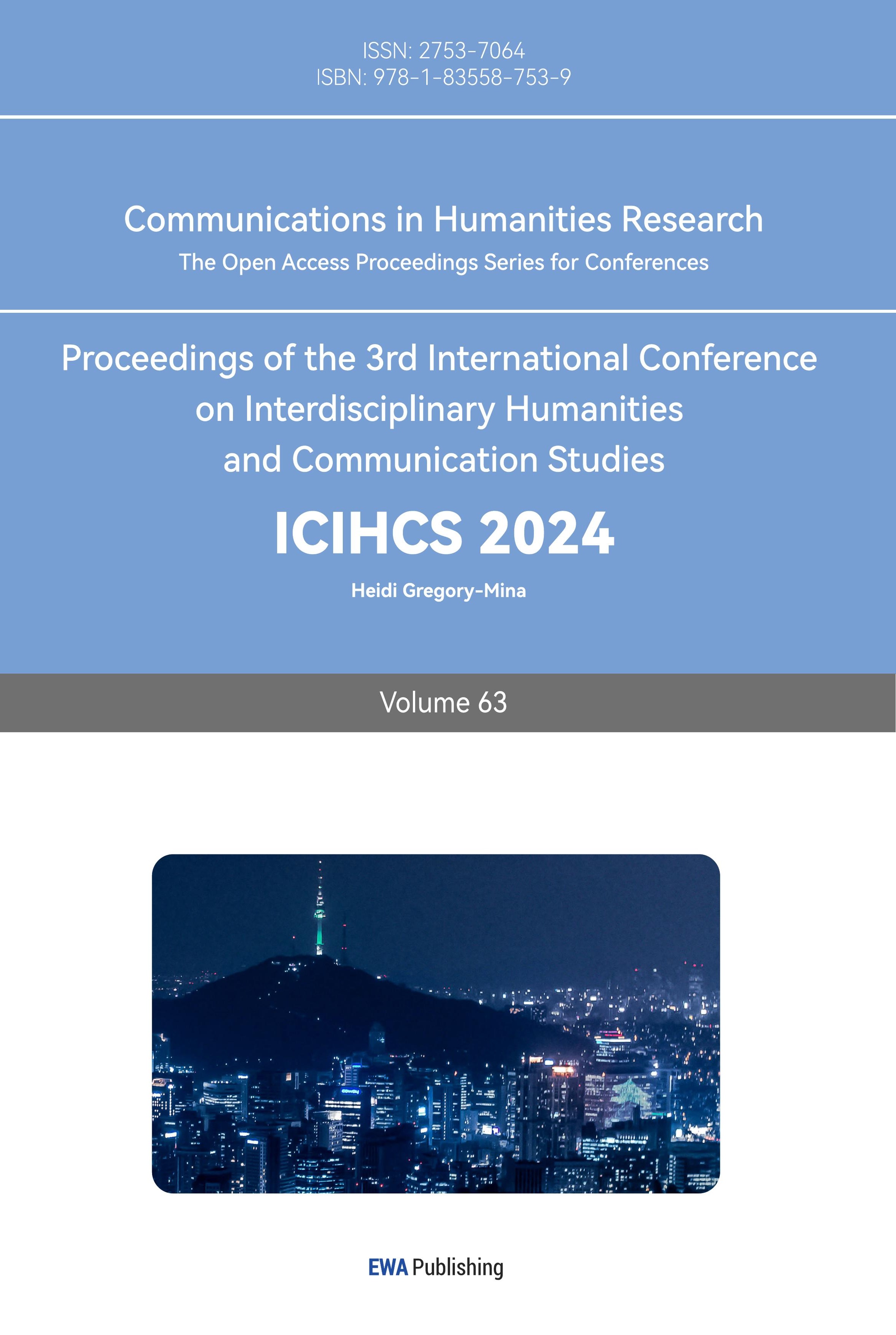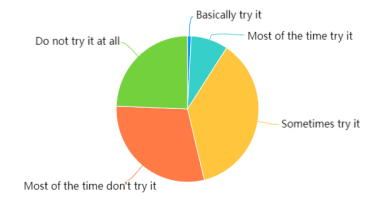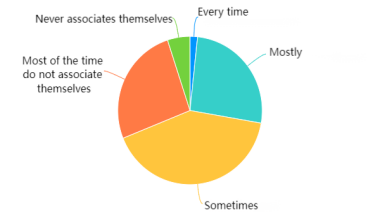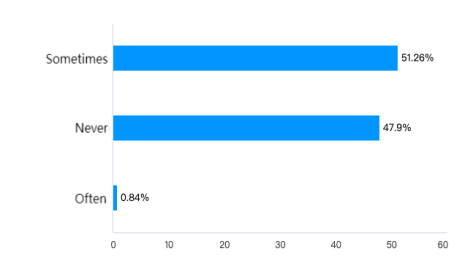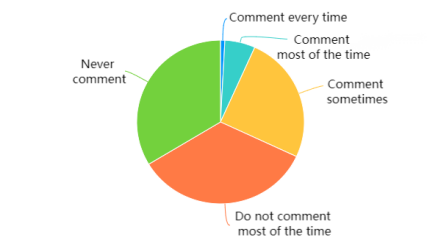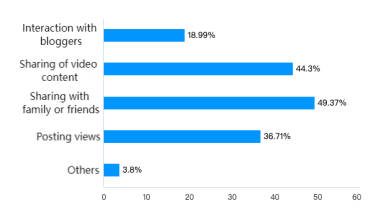1. Introduction
As information technology rapidly developed and spread with the constant invasion of multiculturalism, young people display a much broader and more tolerant attitude towards the concept of marriage and the pursuit of free and equal romantic relationships, but they also face pressures on many fronts. According to recent data from the Ministry of Civil Affairs of the People's Republic of China, the number of marriages in China has continued to decline since 2013, and the age of first marriage has been delayed year by year, which reflects a decrease in youth's desire for marriage and the prevalence of late marriages. In this context, as an essential platform for young people to obtain information, express themselves and establish social relationships, social media has a two-sided effect on both the behavior and psychology of young people [1].
Douyin is one of the current social media highly sought after by youth groups, and the platform is dominated by the dissemination of short-video information. The existence of a large number of couple-type short video content on the platform presents the interaction of real couples to the platform users. While providing viewers with emotional comfort and case references, it directly triggers young audiences to think about marriage and love [2].
The purpose of this study is to research and analyze the reasons for the evolution of contemporary young people's views on marriage and love in order to better understand the evolution of contemporary young people's views on marriage and love. This paper collects and analyzes the viewing experience, emotional reaction and behavioral changes of young audiences by means of questionnaire survey, and analyzes the attitudes of young audiences towards love and marriage, the change of their perception of marriage and its direction in the process of summarizing the dissemination of short videos of couples.
2. Young people's views on marriage and love
2.1. Overview
According to data given by the Ministry of Civil Affairs of the People's Republic of China, the number of marriages in China has declined for nine consecutive years to 6.835 million pairs in 2022, after reaching a peak of 13.469 million pairs in 2013. And the average age of first marriage in China in 2020 will be 28.67 years old, an increase of 3.78 years from the average age of first marriage in 2010 [1]. These figures reflect a decrease in Chinese youth's desire for marriage in recent years, along with the increasing prevalence of late marriages. Accompanied by the rapid social and economic development, rapidly spreading information technology and diversified cultural thinking, young people have consciously and unconsciously accepted a large number of highly differentiated concepts, which has led to their concept of marriage and love undergoing a profound transformation. On the one hand, they are more in pursuit of free and equal romantic relationships, emphasizing personal growth and emotional experience; on the other hand, they are also facing pressures from various aspects, such as family, society and the economy, which have led to their decision-making on marriage and love becoming more complicated and cautious.
2.2. Current situation
Young people show a more open and tolerant attitude towards gender relations and are no longer bound by traditional gender roles and relationship patterns. With the continuous awakening of women's consciousness, the traditional family division of labor model of “man in charge of the outside world and woman in charge of the inside world” is gradually replaced by the division of labor model of “husband and wife in charge of the outside world”. Currently young people of both sexes generally believe that maintaining the daily expenses of the family after marriage requires the joint efforts of both parties. There is also a high degree of unanimity in favor of shared responsibility in the distribution of household chores [3]. This also shows that young people nowadays value the quality of marriage and tend to establish equal and mutually respectful partnership. At the same time, non-traditional marriage models such as non-maritalism, dinks and homosexuality are accepted by more people. The notion that marriage is not for inheritance and is no longer even a necessity is becoming more popular among young people.
2.3. Influencing factor
2.3.1. Family
Family is an important factor influencing the shaping of young people's views on marriage and love. College students who grow up in families where parents have harmonious marital relationships tend to be more stable and traditional in their views on marriage and love. On the contrary, those whose parents have a strained marital relationship and are frequently exposed to negative marital emotions have a negative outlook on marriage. However, the strength of parental influence on college students' attitudes toward marriage diminishes vertically as children mature and become mentally and economically independent of their parents as they grow older [4]. First, spatial separation naturally weakens parents' direct intervention in their personal emotional life. Second, the social circle of college students has gradually changed from family-centered to peer-led, and their ties with their families tend to be looser, while the school environment has a more significant influence on them [5].
2.3.2. Education
With the increase in education level and the intensification of competition for employment, young people often need to devote more time and energy to personal growth and career development. The higher the level of education, the weaker the college students' conception of the traditional marriage audience's door-to-door relationship, and they are also able to understand the division of gender roles in the family with a more open and dialectical perspective [6]. In addition, the increase in economic independence also makes young people more free and independent in their choice of marriage, and no longer overly dependent on the economic support of the family or society.
2.3.3. Internet and social media
The popularization of the Internet and social media has dramatically changed the way youth socialize and the channels of information acquisition. On the one hand, online socialization is communicated through online platforms with a certain sense of distance and virtuality, which makes it more convenient to expand the social circle, and the chance of contacting with the opposite sex is also invariably increased [7]. On the other hand, the network is full of different views and arguments about marriage and relationships, and there are also a variety of relationship and marriage cases presented. These diversified and open information are mixed with strong individualism and feminism in western culture, and at the same time are full of introversion and subtlety in eastern traditional culture. This has broadened the young people's knowledge and horizons in terms of partner choice, relationship patterns, family concepts, fertility and sexuality.
3. Impact of social media communication on youth
3.1. Impact
The size and activity of social media users has grown dramatically, with nearly 60% of the global population having become social media users, and the amount of time spent on social media each day has increased year by year, especially among teenagers in the 16-24 age group, who spend up to 40% of their time on the Internet, reflecting the deeper penetration of social media into the lives of the younger generation [8]. This trend reflects the deep penetration of social media into the lives of the younger generation. This provides adolescents with unprecedented opportunities for self-expression, identity-seeking, and social networking, while exacerbating the material pressures, mental health challenges, and social skills needs they face.
The impact of social media on adolescent mental health is multifaceted. On the one hand, social media provides a platform for adolescents to explore and express themselves, enabling them to discuss various issues more freely [9-10]. In addition, social media provide adolescents with a convenient online communication platform, which greatly increases the scope, frequency, and quality of adolescents' social interactions. On the other hand, social media cause some psychological torture to users due to cyberbullying, privacy leakage and other problems, while false or extreme information can mislead teenagers to establish their values [11-13]. Unlike real-life situations, social media sites are filled with optimized or idealized versions of personal experiences that can exacerbate low self-esteem or jealousy in adolescents [14-15]. At the same time, the overuse of social media also deprives adolescents of the ability to communicate offline, with biased thinking and weakened emotional communication.
In recent years, social media has been deeply integrated into the daily life of youth groups, constructing an irreplaceable and important information and thought dissemination channel, and becoming an important platform for sharing and reflecting the contemporary phenomenon of marriage and love and its related discussions. It not only brings together diversified ideas and cultures, but also promotes the intense collision and deep integration of diversified ideas and cultures, thus potentially influencing to a certain extent the young generation's cognition, attitudes and behavioral patterns towards marriage and love.
3.2. Theoretical foundation
3.2.1. DouYin
China's short-video user base will reach 700 million by 2020, of which 61% of young users aged 25 and below consider DouYin as their most frequently used short-video platform, compared to 21.5% for Kuaishou. The fact that DouYin is so far ahead of other social media programs and so highly sought after by youth groups in China stems from its unique algorithmic mechanism and content ecology. Through its accurate algorithmic recommendation, DouYin constantly recommends to users what they are interested in, thus increasing the length of use and stickiness of users, and enhancing the possibility of shaping the interests and even values of the youth group.
3.2.2. Couple bloggers
In today's fast-moving society, marriage is no longer a necessity in the eyes of young people, and watching others in love has become a new trend, bringing emotional comfort to people. Although there is a huge market for movie and TV dramas and variety shows in the romance genre, the emotional world constructed through the presence of choreographed traces is difficult to satisfy the real emotional needs of the viewers deep inside. As a result, couple-type short videos that show real couple interactions have gained more and more attention.
Common video types include pets, beauty, music, fitness, food, and other restrictive terms, while couples are essentially a description of performers, with them as the main performers and centered around individual videos to focus on their emotional life. On Douyin platform, among the accounts with a fan base of 10 million or more, there are short video bloggers in the couple category, such as “Damowang”, “Dongdong and 37”, and “Fangyangdexinxin”. “DalanggouZhengjianpeng & Yanzhen Couple” has 66,111,000 followers, and in March 2020, it was ranked in the Douyin Top 10 most popular bloggers. In view of Douyin's popularity as a social media in China and the wide audience of couple video bloggers on the platform, which is highly related to marriage and love, this paper chooses to use couple videos on Douyin as an entry point to explore its influence on youth's views on marriage and love and the path of influence.
4. Methodology
4.1. Data collection
The study in this paper focuses on the youth audience group of couple-type short videos on the Douyin platform, and collects data by designing and distributing an online questionnaire. The distribution channels of the questionnaires covered Weibo Super Talk, WeChat Friend Circle and QQ Dynamic, and the age limit of the respondents was between 17-26 years old, and finally 134 questionnaires were successfully recovered. After excluding 13 samples of respondents who had hardly followed the couple short video bloggers on the Douyin platform and 2 samples of respondents who answered the questions for less than 30 seconds, 119 valid samples were finally obtained, with a valid sample recovery rate of 88.8%. Among these valid samples, females occupied the majority, accounting for 81.5%, showing a higher degree of participation.
4.2. Related work
4.2.1. DouYin
China's short-video user base will reach 700 million by 2020, of which 61% of young users aged 25 and below consider DouYin as their most frequently used short-video platform, compared to 21.5% for Kuaishou. The fact that DouYin is so far ahead of other social media programs and so highly sought after by youth groups in China stems from its unique algorithmic mechanism and content ecology. Through its accurate algorithmic recommendation, DouYin constantly recommends to users what they are interested in, thus increasing the length of use and stickiness of users, and enhancing the possibility of shaping the interests and even values of the youth group.
4.2.2. Couple short videos
In today's fast-moving society, marriage is no longer a necessity in the eyes of young people, and watching others in love has become a new trend, bringing emotional comfort to people. Although there is a huge market for movie and TV dramas and variety shows in the romance genre, the emotional world constructed through the presence of choreographed traces is difficult to satisfy the real emotional needs of the viewers deep inside. As a result, couple-type short videos that show real couple interactions have gained more and more attention.
Common video types include pets, beauty, music, fitness, food, and other restrictive terms, while couples are essentially a description of performers, with them as the main performers and centered around individual videos to focus on their emotional life. On Douyin platform, among the accounts with a fan base of 10 million or more, there are short video bloggers in the couple category, such as “Damowang”, “Dongdong and 37”, and “Fangyangdexinxin”. “DalanggouZhengjianpeng & Yanzhen Couple” has 66,111,000 followers, and in March 2020, it was ranked in the Douyin Top 10 most popular bloggers. Meanwhile, there are also couple bloggers who are popular among users for their distinctive video styles and characters. For example, “AriaAndBrandon” is a multinational couple video blogger, whose video content mainly highlights the fusion and collision between Eastern and Western cultures. In addition, “Fenweishuaigejiexika,” often uses cinematic filming or narrative techniques to share emotional experiences. In view of Douyin's popularity as a social media in China and the wide audience of couple video bloggers on the platform, which is highly related to marriage and love, this paper chooses to use couple videos on Douyin as an entry point to explore its influence on youth's views on marriage and love and the path of influence.
4.3. Results
The results of the questionnaire for different questions are shown in Figure 1. On Question 1 about “whether short couple videos changed viewers' perception of certain issues in romantic or marital relationships”(Figure 1 (a)), 40% of young people said they were likely to be “more cautious about relationships and marriage” or “looking forward to relationships”, while 30% of young people felt that watching the videos sometimes had “no effect” on them. Overall, a relatively small percentage felt fearful about relationships or marriage. In addition, 67.23% thought that short videos for couples had changed their views on some issues in their romantic or marital relationships. Of these, 32.77% of young people chose “changed some” and 26.05% chose “changed a small amount”. The overall influence is still wide but not deep (Figure 1 (a)). Regarding Question 2, “whether or not to refer to the couple's mode of relationship and behavior in the video in real life” (Figure 1(b)), excluding respondents who thought that short videos of couples hardly changed their views on certain issues in romantic or marital relationships, the remaining 80 respondents' views on marital or romantic relationships were mainly focused on “communication”, “personality independence”, and “financial independence”. This was followed by “gender equality”, “family rights” and “personal rights”. Of these, “communication” received the most attention at 73%. Due to the high level of resonance and recognition that couple videos gained among viewers, some viewers would refer to the couple's mode of getting along and behavior in the videos to try it out in real life (75.63%) (Figure 1 (b)). More than 62% of the respondents received positive feedback on their attempts, and about 36% of the respondents believed that this practice would not bring significant changes to the couple's relationship.
In addition, in Question 3 “whether or not emotionally related short videos remind them of their own emotional experiences” (Figure 1 (c)), videos are easily accepted as a way to convey emotional expression, so all viewers of relationship videos are infected by the emotions conveyed by the videos. And short videos in which couples share their emotional experiences usually easily remind viewers of their own emotional experiences during viewing, and only 5.04% of respondents disagreed with this view (Figure 1 (c)). For Question 4, “whether or not to recall the content of the video” (Figure 1 (d)), emotionally related video content will remain in viewers' memory for a longer period of time due to its touching effect on viewers, and 52.1% of respondents will recall the content of the video after watching it (Figure 1 (d)).
Bloggers choose and present short video content to a large extent to get more audience participation and interaction, including comments, retweets and shares. In the interaction statistics after watching couple-themed videos, in response to Question 5, “whether or not to participate in the discussion in the video comment section”(Figure 1 (e)), 66.39% of the respondents indicated that they would participate in the discussion in the comment section most of the time or every time (Figure 1 (e)). However, the result of Question 6 on “Why and how do you participate in the comments”(Figure 1 (f)) shows that the comments were mainly about sharing the video for family or friends (49.37%).
(a) |
(b) |
(c) |
(d) |
(e) |
(f) |
Figure 1: Results of different questions in the questionnaire: (a) Question 1; (b) Question 2; (c) Question 3; (d) Question 4; (e) Question 5; (f) Question 6
5. Discussion
The dissemination of short videos on couples has been able to change most young people's attitudes towards marriage and love. First of all, it has not led to the collective fear of young people about marriage and love or the loss of the beautiful desire for marriage and love; on the contrary, it has prompted young people to face it with a more prudent attitude, while at the same time, some young people have maintained rational and independent thinking and are not easily swayed by the content of short videos. Such a trend of attitude change is conducive to youth shaping a healthy and stable view of marriage and love. Further research found that the dissemination of short videos of couples can change most of the youth's views on marriage and love, but this shift is not a comprehensive reversal of the established concepts, but rather a reassessment of certain topics in marriage and love, and there are certain limitations in the depth and breadth of the impact on the youth group. These changed views mainly focus on “communication”, “personality independence” and “economic independence”, and it is easy to see that young people want to maintain their independence and autonomy in love or marriage. It is easy to see that young people prefer to remain independent in their relationships or marriages, and they emphasize personal space and career planning rather than relying entirely on their partners' company or financial support. On the whole, young people's perception of relationships is stronger than that of marriages, on the one hand, due to the limitation of age, they haven't been able to have actual experience of marriage, on the other hand, it may also be due to the fact that short videos of couples show less of marriages compared to relationships.
In the analysis of the path of influence on the view of marriage, first of all, the short videos of couples have a strong emotional contagion to the youth audience instantly. Through humorous or touching content, they inspire youth to have empathy, thus deepening their memory and understanding of the video's viewpoints. This process not only enhances the youth's attention to the topic of marriage and love, but also promotes their in-depth thinking on related topics. Secondly, the dissemination of the video content prompts youth to engage in interactive discussions on social media platforms. Some young people “tweet” their family members and friends in the comment section to watch the video together, which triggers a discussion and promotes their reflection on the issue of marriage and love. Although on the whole, young people do not have a high willingness to learn from the content of short videos for couples, those who choose to imitate the content of short videos for couples will not get any negative effects, on the contrary, most of them are likely to get positive feedback, which can also encourage young people to try to learn more. Therefore, couple short videos promote youth's reexamination and construction of marriage and love cognition through the mechanisms of emotional resonance, social interaction and positive feedback.
6. Conclusion
The results of this study suggest that short videos for couples promote youth to face marriage and relationships in a more cautious and rational manner while maintaining their good expectations for relationships, which helps to shape a healthy outlook on marriage and relationships. Regarding the specific direction of influence, the importance they place on maintaining personal space and autonomy in a relationship or marriage is significantly higher. In addition, the emotional resonance and social interaction as well as the positive feedback after learning from the video content facilitated the youth's reexamination and construction of the marriage and love issue, but the influence of short videos for couples still needs to be viewed dialectically, with both positive guidance and potential limitations.
This study still has some shortcomings that need to be improved, the sample is not balanced between men and women, and the results of the study may tend to favor the ideas of female youth, which is not representative of the whole group of youth. Secondly, this study basically failed to address whether short videos of couples influenced the two aspects of young people's views on marriage and love, namely fertility intention and sexuality, which may have limited the description of marriage and love to aspects such as partner choice and relationship patterns. Therefore, it is suggested that further research could be conducted in the future to fill in the missing aspects and to collect a larger sample of male youth.
References
[1]. Qin C.“Marginalized People” and ‘Chinese Style Matchmaking’--Marriage and Mate Choice Behavior of Chinese Youth in Transition[J].China Youth Study, 2017(07).
[2]. Knox, D, & Sporakowski, M.Attitudes of college students toward love[J]. Journal of Marriage and the Family, 1968, 30(4), 638-642.
[3]. Yin, K, Li, X, Sun, J, & Yu, H. Social network of college students[J].Advances in Psychological Science, 2016, 24(8), 1279-1289.
[4]. Li, X.Research on the Influencing Factors of College Students' Marriage View from the Perspective of Social-Ecological System[D]. Shandong University, 2022.
[5]. Tan, Z. An analysis of the cultural elements affecting the view of contemporary youth marriage in China[J].Guangdongqingnianyanjiu, 2023, 37(04):82-92.
[6]. Xuan, C, Wang, X.The effect of social media advertising exposure on the materialistic tendencies of Chinese youth groups[J].Journalism & Communication Review, 2024, 77(01): 117-128. DOI:10.14086/j.cnki.xwycbpl.2024.01.010.
[7]. Pascoe C J. Resource and risk: Youth sexuality and new media use[J]. Sexuality research and social policy, 2011, 8(1): 5-17.
[8]. Craig S L, Eaton A D, McInroy L B, et al. Can social media participation enhance LGBTQ+ youth well-being? Development of the social media benefits scale[J]. Social Media+ Society, 2021, 7(1): 2056305121988931.
[9]. Elphinston R. A., Noller P.. Time lo Face It! Facebook Intrusion and the Implications for Romantic Jealousy and Relationship Satisfaction. Cyberpsy-chology, Behavior, and Social Networking, vol. 14, no. 11, 2011. pp. 631 - 635.
[10]. Baltaci. The Predictive Relationships between the Social Media Addiction and Social Anxiety, Loneliness, and Happiness. International Journal of Progressive Education, vol. 15, no. 4, 2019. pp. 73 - 82.
[11]. Wang L., Luo J., Bai Y., Kong J., Luo J., Gao W., Sun X.. Internet Addiction of Adolescents in China: Prevalence, Predictors, and Association with Well-Being. Addiction Research & Theory, vol. 21, no.1, 2013. pp. 62 - 69.
[12]. Haferkamp N, Kramer NC. Social comparison 2.0: Examining the effects of online profiles on social-net-working sites. Cyberpsychol Behav Soc Netw. 2011; 14(5):309–14. https://doi.org/10.1089/cyber.2010.0120 PMID: 21117976
[13]. Vogel EA, Rose JP. Self-reflection and interpersonal connection: Making the most of self-presentation on social media. Transl Issues Psychol Sci. 2016; 2(3):294.
[14]. Sheela K D. Effectiveness Of Social Media On Youth In Relation To Their Social Life In Kerala[J]. Turkish Journal of Computer and Mathematics Education (TURCOMAT), 2021, 12(6): 923-933.
[15]. Cheng, Q.Gathering without Groups: A Phenomenological Perspective and Formation Logic of Young People's “Lonely Socialization” in the Age of Social Media[J].Contemporary Youth Research, 2023, (05):74-84.
Cite this article
Huang,K. (2024). The Influence of Social Media on Youth's Views on Marriage and Love--The Example of Short Videos of Couples on Douyin. Communications in Humanities Research,63,122-129.
Data availability
The datasets used and/or analyzed during the current study will be available from the authors upon reasonable request.
Disclaimer/Publisher's Note
The statements, opinions and data contained in all publications are solely those of the individual author(s) and contributor(s) and not of EWA Publishing and/or the editor(s). EWA Publishing and/or the editor(s) disclaim responsibility for any injury to people or property resulting from any ideas, methods, instructions or products referred to in the content.
About volume
Volume title: Proceedings of 3rd International Conference on Interdisciplinary Humanities and Communication Studies
© 2024 by the author(s). Licensee EWA Publishing, Oxford, UK. This article is an open access article distributed under the terms and
conditions of the Creative Commons Attribution (CC BY) license. Authors who
publish this series agree to the following terms:
1. Authors retain copyright and grant the series right of first publication with the work simultaneously licensed under a Creative Commons
Attribution License that allows others to share the work with an acknowledgment of the work's authorship and initial publication in this
series.
2. Authors are able to enter into separate, additional contractual arrangements for the non-exclusive distribution of the series's published
version of the work (e.g., post it to an institutional repository or publish it in a book), with an acknowledgment of its initial
publication in this series.
3. Authors are permitted and encouraged to post their work online (e.g., in institutional repositories or on their website) prior to and
during the submission process, as it can lead to productive exchanges, as well as earlier and greater citation of published work (See
Open access policy for details).
References
[1]. Qin C.“Marginalized People” and ‘Chinese Style Matchmaking’--Marriage and Mate Choice Behavior of Chinese Youth in Transition[J].China Youth Study, 2017(07).
[2]. Knox, D, & Sporakowski, M.Attitudes of college students toward love[J]. Journal of Marriage and the Family, 1968, 30(4), 638-642.
[3]. Yin, K, Li, X, Sun, J, & Yu, H. Social network of college students[J].Advances in Psychological Science, 2016, 24(8), 1279-1289.
[4]. Li, X.Research on the Influencing Factors of College Students' Marriage View from the Perspective of Social-Ecological System[D]. Shandong University, 2022.
[5]. Tan, Z. An analysis of the cultural elements affecting the view of contemporary youth marriage in China[J].Guangdongqingnianyanjiu, 2023, 37(04):82-92.
[6]. Xuan, C, Wang, X.The effect of social media advertising exposure on the materialistic tendencies of Chinese youth groups[J].Journalism & Communication Review, 2024, 77(01): 117-128. DOI:10.14086/j.cnki.xwycbpl.2024.01.010.
[7]. Pascoe C J. Resource and risk: Youth sexuality and new media use[J]. Sexuality research and social policy, 2011, 8(1): 5-17.
[8]. Craig S L, Eaton A D, McInroy L B, et al. Can social media participation enhance LGBTQ+ youth well-being? Development of the social media benefits scale[J]. Social Media+ Society, 2021, 7(1): 2056305121988931.
[9]. Elphinston R. A., Noller P.. Time lo Face It! Facebook Intrusion and the Implications for Romantic Jealousy and Relationship Satisfaction. Cyberpsy-chology, Behavior, and Social Networking, vol. 14, no. 11, 2011. pp. 631 - 635.
[10]. Baltaci. The Predictive Relationships between the Social Media Addiction and Social Anxiety, Loneliness, and Happiness. International Journal of Progressive Education, vol. 15, no. 4, 2019. pp. 73 - 82.
[11]. Wang L., Luo J., Bai Y., Kong J., Luo J., Gao W., Sun X.. Internet Addiction of Adolescents in China: Prevalence, Predictors, and Association with Well-Being. Addiction Research & Theory, vol. 21, no.1, 2013. pp. 62 - 69.
[12]. Haferkamp N, Kramer NC. Social comparison 2.0: Examining the effects of online profiles on social-net-working sites. Cyberpsychol Behav Soc Netw. 2011; 14(5):309–14. https://doi.org/10.1089/cyber.2010.0120 PMID: 21117976
[13]. Vogel EA, Rose JP. Self-reflection and interpersonal connection: Making the most of self-presentation on social media. Transl Issues Psychol Sci. 2016; 2(3):294.
[14]. Sheela K D. Effectiveness Of Social Media On Youth In Relation To Their Social Life In Kerala[J]. Turkish Journal of Computer and Mathematics Education (TURCOMAT), 2021, 12(6): 923-933.
[15]. Cheng, Q.Gathering without Groups: A Phenomenological Perspective and Formation Logic of Young People's “Lonely Socialization” in the Age of Social Media[J].Contemporary Youth Research, 2023, (05):74-84.





